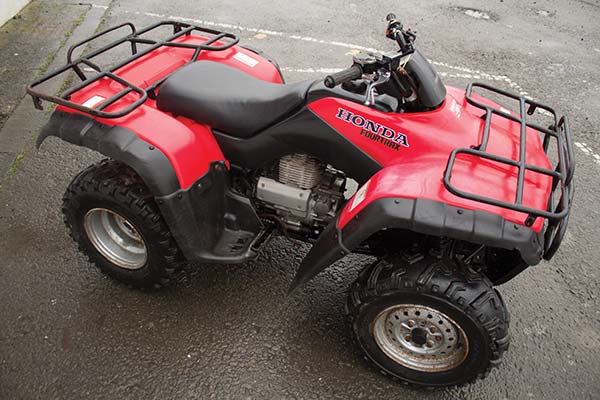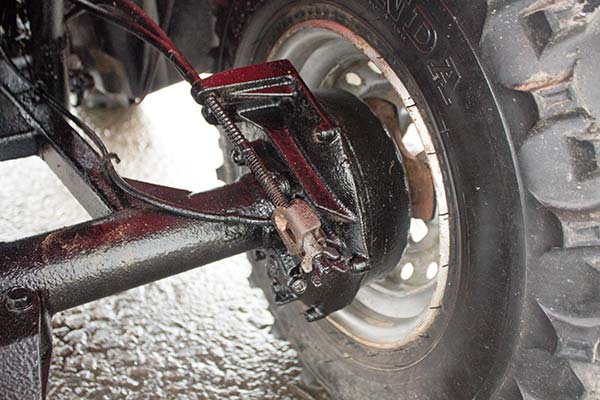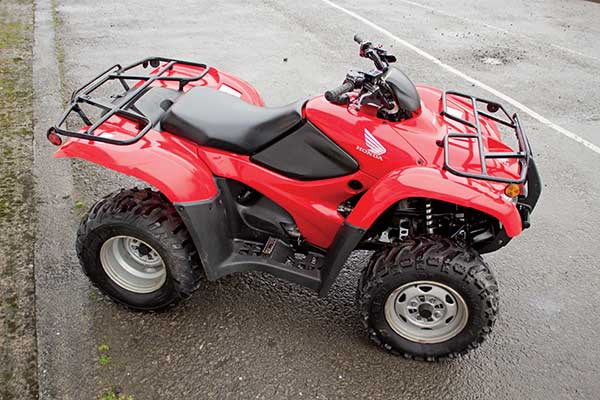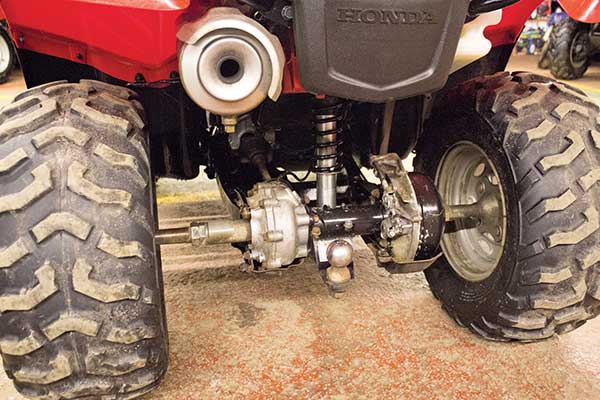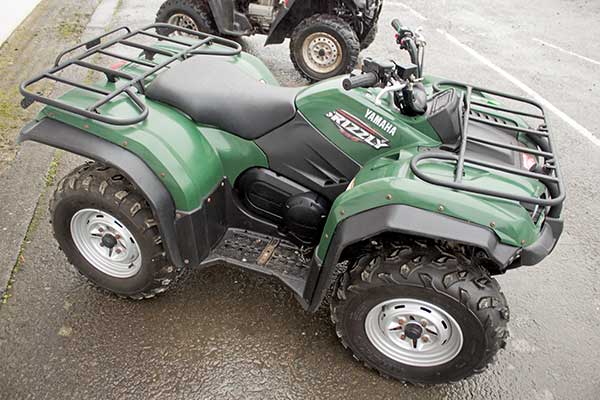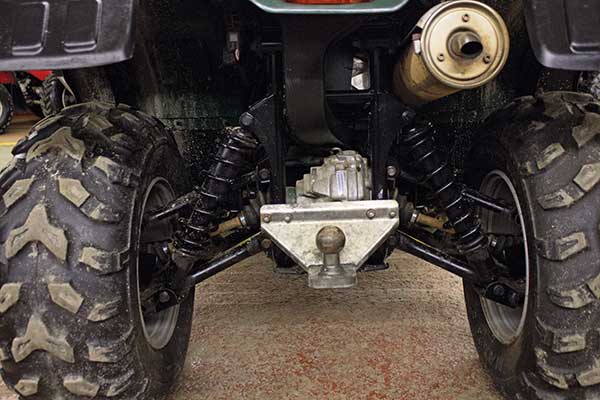The low-down on buying a second-hand ATV
Getting hold of a decent used ATV with £2,500 in your back pocket sounds simple enough.
But after several phone calls enquiring about bikes for sale in the southern counties we were still struggling to find anything worth having.
So we hopped in the car and headed deep into the Welsh valleys.
John Dalton is one of the biggest ATV dealers in the UK with more than 100 used bikes in stock at any one time, so it was the ideal place to hunt down a quality used bike.
We’ve taken a closer look at three bikes.
See also: ATV news, reviews and buying advice
Honda Fourtrax 350
Price: £1,800 plus VAT
Year: 2002
Previous history: Trade-in from a forestry worker that switched to a UTV. It’s been though Mr Dalton’s workshop, but could do with a new cam chain in the next year or so.
Hours: 3,300/29,100km
Engine: 350cc inline air-cooled Honda engine
Transmission: Five-speed manual with reverse
Tyres: 75% front and 50% rear
Suspension: Beam axle and single shock
Condition: Tidy and straight bike, but could do with a replacement cam chain and a lick of paint over the front and rear racks.
The tyres might also want changing if you were planning to drive it in really sticky stuff.
What to look out for when buying this model?
Listen out for noisy cam chains. A slight rattle isn’t too serious, but if it’s making a loud slapping noise there’s too much slack and it could be on the verge of jumping teeth or snapping completely.
A replacement will cost about £250.
Rev the engine up from idle and listen for any piston slap. It’s a sign that there’s too much space between the piston and cylinder wall and will probably be loudest while the engine is cold.
It could mean a rebore and new set of piston rings is on the cards. That will cost about £350-450, but if the engine is ever run until it seizes, the bill will run well above £500.
CV joints are vulnerable to wear and tear. Turn the steering to full lock and listen for a ticking noise. It costs about £250 a side to replace them.
Aggressive drivers can shred front prop shaft spines, which breaks the drive to the front wheels.
This can be difficult to spot if you only take it for a spin around the yard because the rear wheels will still propel the bike. Prop shaft kits cost about £200.
Gear shaft seals can be dislodged on older Hondas. Look for seepage where the shaft exits the gearbox and for any suspicious signs that the oil has been topped up just before your visit.
A hard life and lack of servicing can take its toll on outrigger bearings. Shake the wheels and look for play in the front hubs and rear left-hand outrigger bearing.
Replacements cost are £60 for front bearings and seals (both sides) and £30 for outrigger bearing and seals.
Honda 420 2wd
Price: £2,500 (expect to pay £3,400 for a 4wd version in similar condition) plus VAT
Previous history: Owned by long-standing Dalton’s customer and has a good service history.
Year: 2009
Hours: 1,250 hours/12,000km
Engine: 420cc inline Honda engine
Transmission: Five-speed manual with reverse
Tyres: 50% front and 65% rear
Suspension: Single rear shock on fixed axle, double wishbone on front
Condition: Tidy bike all round and hasn’t had to have any major work carried out since it left the farm.
Will have the rear axle stripped and a full service by Dalton’s before resale, but is photographed in off-farm condition – these are the gems to look out for.
What to look out for when buying this model?
The rear axle is the biggest bugbear on a 420. If it isn’t stripped and serviced regularly it can self-destruct. Check for signs of trouble by grabbing and twisting the axle tube to the left of the diff.
If it turns, it will need stripping and servicing. Check for more serious wear by grabbing and shaking the bike.
If there is more than 15mm of play in the axle from side to side, it probably means mud has got past the seal, into the diff and worn the axle shaft and crown sheel splines.
If so, the whole axle could need replacing at a cost of £200 for the axle shaft and £330 for the crown wheel and relevant bearings.
Dog teeth in the gearbox are prone to wear on this model and it’s a £600-700 job to put it right. It is generally caused when people don’t let off the throttle enough before banging it into gear.
Check for wear by flicking up the gears and feeling for a clunking as the gears engage.
Yamaha Grizzly 450
Price: £2,850 no VAT
Year: 2008
Hours: 2,230 hours/13,609 miles
Previous history: A trade-in bike from a smallholder who was the second owner.
Engine: 450cc motorcycle-style setup.
Transmission: Belt-driven CVT transmission
Tyres: New Maxxis tyres
Suspension: Independent wishbone suspension all round.
Condition: Excellent original condition with little sign of wear. It’s also got the original seat cover in good nick, which means it has led a fairly sheltered life.
Extra features: Higher spec than an equivalent Honda with high/low gearbox, transmission brake/parking lock, selectable two- and four-wheel drive and diff-lock with override.
What to look out for when buying this model?
Oil-immersed rear brakes within the diff casing are maintenance free and are very good but can cause problems.
If the rear foot brake is playing up, alarm bells should ring – take the plug out of the diff and sniff it. If it smells burnt then the brakes have been cooked and need replacing. This will cost about £350 to fix.
Because it’s got independent suspension all round, it is worth checking all the A-arm bushs and CV joints for wear. Look out for damaged gaiters, too.
The Hardy Spicer-type joints on the front and rear prop shafts can cause even the most responsible owners the odd headache.
They run at a slight angle so need greasing, but you have to buy a special tool to get at the nipple. If it has been serviced by a main dealer it won’t be a problem.
If not and it is badly worn you will need to change the whole shaft, which costs about £400 front and £350 rear.
If the shaft has already dropped off the bike, check for damage to the diff housing caused by the shaft flailing about.
Dalton’s ATVS
The Yard, Talsarn, Lampeter, Ceredigion, Wales, SA48 8QB
Beef and sheep farmer John Dalton started his ATV business near Lampeter, west Wales, in 1999.
He runs it alongside the 120ha family farm and sells new Honda, Yamaha and Polaris ATVs alongside an ever expanding utility vehicle line-up and the hundreds of used machines that turn up as trade-ins.
The yard is an ATV mecca for those hunting for a bargain bike. There are plenty of tidy specimens in the showroom, as well as a bunch of battered and bruised machines waiting for some workshop TLC.
Eight fitters work on servicing machines and getting trade-ins shipshape.
Most are given a thorough once-over before being resold, but Dalton’s will also let buyers on a shoestring budget take one in as-seen shape – or tidied up within their budget – provided it has come from a good owner.
The company keeps a fleet of loan bikes to fill the void of any ATVs in the workshop.
It collects and services 600 machines within 60 miles of the base each year, as well as another 700 that are delivered by their owners to the Dalton’s yard for a once-over.
Dalton’s 10 tips for avoiding buying a lemon
On a traditional average farm bike, engine hours should just about mirror the mileage. For example, 1,200 hours should equate to about 12,000km.
If mileage is high relative to hours then it has most likely been run at high speed and revved hard.
- Don’t be fooled by looks. A well-maintained bike is a far better bet than one with straight bodywork and worn internals.
- Shake the handlebars from side to side and look for play in the wheel bearings, track rod ends and upper and lower ball joints. If wheel bearings are left too long, the hub might need to be replaced.
- Check coolant levels on water-cooled bikes and look for any signs of leaks.
- Look out for tired brakes. Some poorly maintained bikes are so worn in the brake department that the pistons push through the pads. It can be hard to tell, but have a drive around, grab the brakes and listen for scraping sounds.
- Swingarm bearings are other items that are prone to wear. Stand on the foot pegs, rock the bike from side to side and listen for knocking.
- Worn steering arm bearings are another tell-tale sign that a bike has had a hard time of it. Stand on the foot pedals and lift the handle bars up to see if there’s any movement.
- Lift the seat, open the air cleaner and check that the filter is clean. If it is dirty, the bike hasn’t been serviced recently.
- It sounds obvious, but dip the oil. If it’s off the dipstick the engine could be worn. If the oil is suspiciously clean and the bike has not been serviced, it is likely it has been topped up just before your visit.
- On Honda bikes look out for correctly tensioned cable adjuster on the rear brakes. If this has a long tail on the cable or is seized, it hasn’t been properly maintained recently.
How to avoid buying a stolen bike?
ATVs are the prey of choice for rural robbers. Small enough to lift on to trailers, easy to hide and with few security features, they’re quick and easy business for the average farm thief.
However, there are a few ways that you can reduce the chances of buying a nicked one.
Start with checking the key. It should be branded and genuine with the name of the manufacturer printed on the plastic.
If it’s not, or if the barrel is damaged and the spring-loaded flap hangs open, then ask a few more questions about its history. There is a chance someone might have been at it with a screwdriver.
Also ask for proof of purchase. Any respectable owner will keep receipts and possibly even the history of any servicing done by local dealers.
An original operator’s manual is also a good sign that it’s coming from a legitimate owner.
Check the chassis number – it is usually just behind the horn on a Honda. It might mean scraping back oil, underseal or paint to find it.
Experienced thieves sometimes try and cover their back by grinding the number off and repainting, so look closely.
The 10th digit on chassis number is the year of manufacture on a Honda – check it tallies up with the paperwork.
There are also a few things on the market to try to reduce thefts.
The most high-tech is a tracking device, which can be buried in the bowels of the machine and sends out GPS co-ordinates that can be used to locate the bike.
A tracker kit will cost about £250, but there’s also an annual subscription to pay after the first year.
There are other more rudimentary forms of defence.
Chains and anchors can do a decent job of locking it in place, while you can also get a claw-type frame that mounts to a wall and folds down to clamp around the handlebars like a muck grab.

